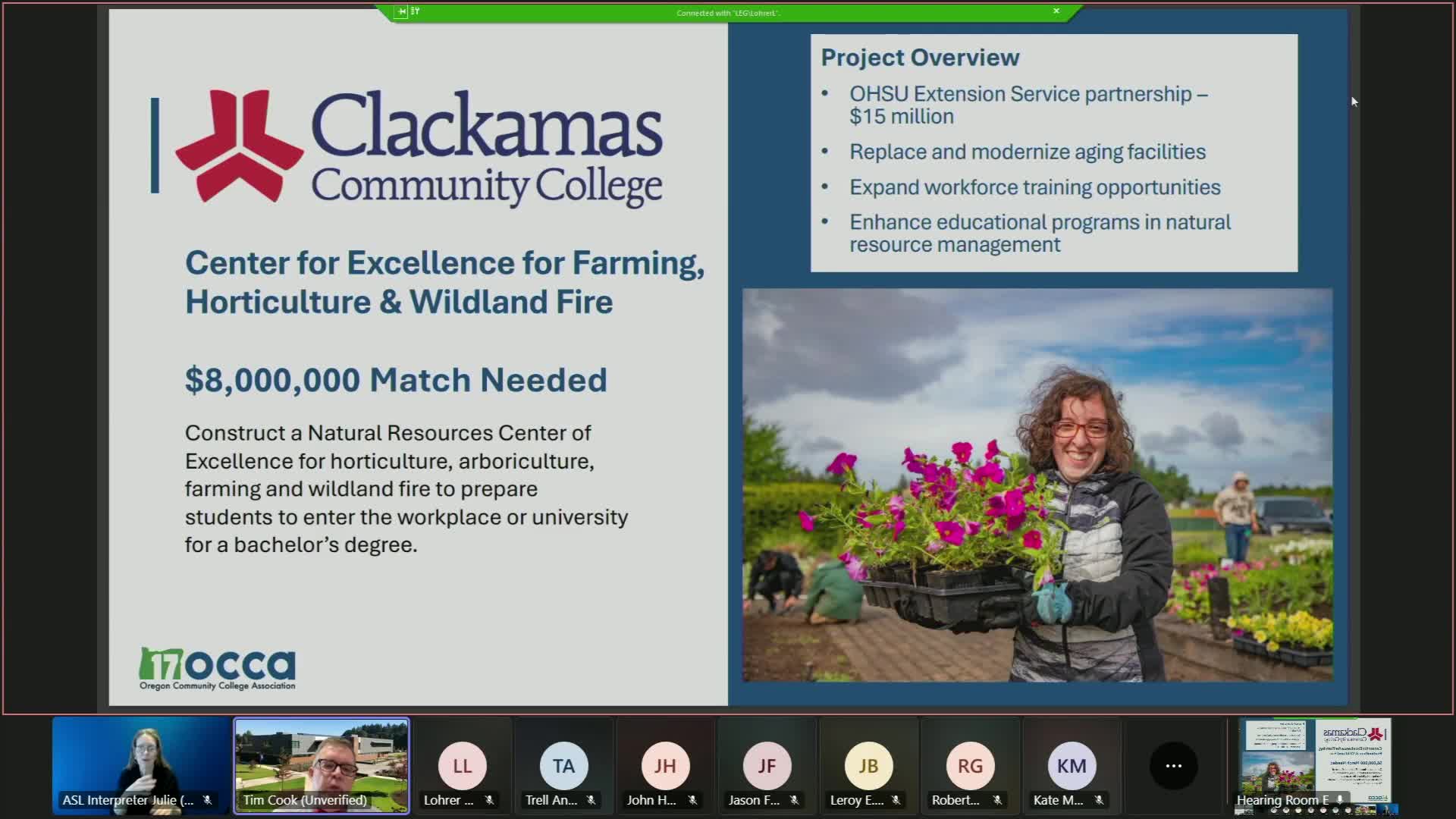Klamath and Mt Hood Community Colleges request $8M each for new facility upgrades
May 02, 2025 | Capital Construction, Ways and Means, Joint, Committees, Legislative, Oregon
This article was created by AI summarizing key points discussed. AI makes mistakes, so for full details and context, please refer to the video of the full meeting. Please report any errors so we can fix them. Report an error »

The Joint Committee on Ways and Means Subcommittee on Capital Construction convened on May 2, 2025, to discuss critical funding requests from various educational institutions in Oregon. The meeting focused on proposals aimed at enhancing educational facilities and addressing workforce development needs across the state.
The session began with a presentation from representatives of Clackamas County, who highlighted the urgent need for a new educational center. This center aims to support local generational farms by providing training and education in modern farming techniques and wildland fire management. The initiative seeks to partner with local nursery businesses and Oregon State University’s extension services to create a state-of-the-art facility that will cater to the growing demand for skilled agricultural workers.
Next, Klamath Community College President Roberto Gutierrez addressed the committee regarding the college's request for $4 million in state funding to construct a new building. Gutierrez explained that the college had previously taken over a failing private institution and revamped its curriculum to include business classes. However, a recent federal audit revealed that the existing 90-year-old building was not ADA compliant and required extensive renovations. The college has secured matching funds and emphasized the importance of this new facility for the community and its students.
Following this, Mt. Hood Community College President Lisa Scarry presented a request for $8 million to modernize the college's aging infrastructure. Scarry outlined plans to renovate classrooms and laboratories, emphasizing that these upgrades are essential for meeting workforce demands and enhancing student success. The proposed improvements include significant upgrades to technology and safety standards, as well as energy efficiency enhancements. Scarry noted that community input has been integral to shaping this request, ensuring alignment with local needs.
Throughout the meeting, the importance of collaboration among Oregon's community colleges was underscored. Scarry, representing the Oregon President's Council, highlighted the thorough vetting process that each capital construction proposal undergoes, ensuring fairness and equity in project selection.
In conclusion, the meeting showcased a collective commitment to improving educational facilities in Oregon, with a focus on addressing workforce needs and enhancing student opportunities. The committee's deliberations will play a crucial role in determining the future of these proposed projects, which aim to foster economic growth and community well-being across the state.
The session began with a presentation from representatives of Clackamas County, who highlighted the urgent need for a new educational center. This center aims to support local generational farms by providing training and education in modern farming techniques and wildland fire management. The initiative seeks to partner with local nursery businesses and Oregon State University’s extension services to create a state-of-the-art facility that will cater to the growing demand for skilled agricultural workers.
Next, Klamath Community College President Roberto Gutierrez addressed the committee regarding the college's request for $4 million in state funding to construct a new building. Gutierrez explained that the college had previously taken over a failing private institution and revamped its curriculum to include business classes. However, a recent federal audit revealed that the existing 90-year-old building was not ADA compliant and required extensive renovations. The college has secured matching funds and emphasized the importance of this new facility for the community and its students.
Following this, Mt. Hood Community College President Lisa Scarry presented a request for $8 million to modernize the college's aging infrastructure. Scarry outlined plans to renovate classrooms and laboratories, emphasizing that these upgrades are essential for meeting workforce demands and enhancing student success. The proposed improvements include significant upgrades to technology and safety standards, as well as energy efficiency enhancements. Scarry noted that community input has been integral to shaping this request, ensuring alignment with local needs.
Throughout the meeting, the importance of collaboration among Oregon's community colleges was underscored. Scarry, representing the Oregon President's Council, highlighted the thorough vetting process that each capital construction proposal undergoes, ensuring fairness and equity in project selection.
In conclusion, the meeting showcased a collective commitment to improving educational facilities in Oregon, with a focus on addressing workforce needs and enhancing student opportunities. The committee's deliberations will play a crucial role in determining the future of these proposed projects, which aim to foster economic growth and community well-being across the state.
View full meeting
This article is based on a recent meeting—watch the full video and explore the complete transcript for deeper insights into the discussion.
View full meeting
